
Formation of Karakalpakstan

|
Formation of Karakalpakstan
|
|
ContentsIntroductionRussian Annexation The Amu Darya Otdel Rising Unrest in Russia The Russian Revolution Reaction in Turkestan Reaction in Khorezm Descent into Civil War The Khorezm Peoples' Soviet Republic The Khorezmian Soviet Socialist Republic Soviet National Delimitation Policy The Karakalpak Autonomous Oblast The Karakalpak Autonomous Soviet Socialist Republic Entry into the Uzbek SSR Post Script References IntroductionKarakalpakstan is an artificial nation, its arbitrary borders drawn across uninhabited stretches of desert and the middle of the Aral Sea by Soviet apparatchiks in the early 1920s. Thus its entire western frontier is determined by the 56th meridian. Its only natural borders are a small section of tchink, along the edge of the Ustyurt plateau (part of which is currently disputed by Turkmenistan), and the right bank of the Amu Darya from Nazarkhan to Drujba.
The arbitrarily drawn borders of todays Karakalpak Autonomous Republic run through remote uninhabited
stretches
|

|
Aware of British concerns over the continued expansion of Russia towards India, Kaufmann was under strict orders not to annex Khorezm – like Bukhara,
the Khanate of Khiva was destined to become a Protectorate of Russia, its Khan being allowed to continue to rule provided that hostilities ceased,
reparations were paid, Russian and Persian slaves were released, and Russian merchants were allowed to establish businesses and trade in the Khanate.
Instead Kaufmann annexed the lands on the right bank of the Amu Darya, forming a new otdel or department to be incorporated within the Syr
Darya Oblast. It was placed under the control of the Russian army who established a new military garrison at Fort Petro-Aleksandrovsk. Its
first Commandant was General Ivanov. In 1874 work began on the construction of a second garrison at Fort Nukus.
The Amu Darya Otdel had two regions, the Shoraxan section in the south and the larger Shımbay section in the north. The majority of
Karakalpaks (about 85%) lived on the right bank and became Russian subjects, leaving the remainder under the rule of the Khivan Khan.
Great interest was shown internationally in the new Russian conquest, but after a few years this began to wane. By the start of the 1900s the Khiva
Khanate and the Amu Darya Division had become forgotten backwaters of the vast Russian Empire. Although Russian merchants had arrived to establish
trading posts and new cotton plantations, the majority of Khorezm's people continued to follow their traditional medieval lifestyle.
Rising Unrest in Russia
Throughout the 19th century there was ever rising pressure against the tsarist regime in Russia, fuelled by the smouldering resentment of the
peasantry towards their feudal masters. Peasants made up about 90% of the population in 1800 and they were effectively owned by their aristocratic
masters, not even free to leave their own villages.
Following Russia's humiliating defeat in the 1854-56 Crimean War, Tsar Aleksandr II introduced some important reforms. The 1861 abolition of serfdom
theoretically freed the peasants, allocating them a portion of their landlord's land. However the reforms had been carefully designed to keep the
peasants tied to the land, ensuring that they would not pose any challenge to the Tsar's absolute autocracy. The landlords had been compensated with
government bonds and so in turn the peasants had to make redemption payments to the state over a period of 49 years. Each village commune or
mir held the peasant land in collective ownership and became responsible for seeing that the redemption payments were made.
Opposition to the tsarist regime had taken many forms during the first half of the 19th century, ranging from the Decembrists to the Nihilists, and
the Westerners to the Slavophiles. In the 1860s the new Populist movement became fashionable, promoted by anti-capitalist agrarian socialists who
argued that traditional village communes should form the basis of a future socialist state. Some believed that socialism could be achieved through
the education of the peasants, but the peasants were suspicious of urban do-gooders and over time the movement became more militant, supporting a
campaign to assassinate government officials.
The assassination of the Tsar in 1881 by an extremist wing known as the "People's Will" simply led to a return to repression under his son, Tsar
Aleksandr III, and an end to reformist thinking. Liberals were dismissed from their posts and the powers of the landlords and secret police were
increased. Tsar Nicholas II (1894-1917) maintained this reactionary position until the end of the 1903-1905 Russo-Japanese War.
In the 1880s further radical movements emerged. The Social Revolutionaries wanted to overthrow the regime and replace it with an agrarian society
based on the collective ownership of the land through the peasant communes. Meanwhile the Social Democrats adopted Marxist ideas, believing that
industrialization would lead to the growth of a large urban working class and ultimately revolution. They formed the Russian Social Democratic Labour
Party in 1898 but it soon divided into opposing camps. Its Second Congress had opened in Brussels in 1903 but was forced to move to London following
police harassment. The majority, known as the Bolsheviks and supported by Lenin, believed that the liberation of the working class could only be
achieved under the leadership of a small number of ruthless professional revolutionaries, while the minority Mensheviks under Martov supported wider
party involvement. Over the following decade the Bolshevik movement continued to strengthen, increasingly raising funds through criminal activities.
The last 20 years of the 19th century witnessed rapid industrialization in Russia, with an increasing number of employees working long hours in
poor conditions. Although illegal there had been a mounting wave of strikes by discontented workers, many of which were put down by the army.
There was also a rising radical student movement in the universities. A national university strike in 1899 was followed by a peasants' revolt in
the Ukraine in 1902 and a socialist terrorist campaign resulted in the assassination of several ministers.
A disastrous war with Japan over Russia's attempt to annex Manchuria only increased dissent. In early 1905 tsarist guards butchered a peaceful
workers' march on the Winter Palace. "Bloody Sunday" as it became known caused a wave of revulsion and unified political opposition. Strikes
and peasant riots eventually escalated into a general strike later that year. The Tsar, unsure as to whether or not to use force, finally opted for
limited reforms including an advisory parliamentary assembly, the Duma, with an upper house (the State Council) and an elected lower house
(the State Duma). However the absolute power of the Tsar was retained and Nicholas II had no hesitation in dissolving the first two Dumas when
they failed to cooperate.
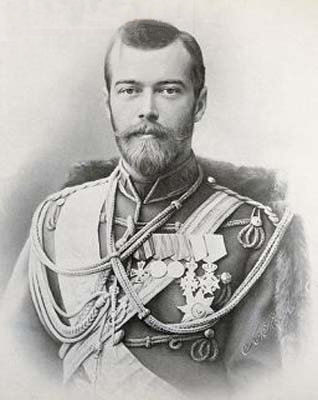
|
The composition of the third Duma was more conservative, with less representation of the lower classes. It lasted for a full five years, from
1907 to 1912, combining repression with a few reforms and an associated period of relative calm. Prime Minister Stolypin sought to gain peasant
support by creating a class of independent and prosperous peasants. Redemption payments were cancelled, loan facilities were made available,
and peasants were encouraged to consolidate their land into larger farms, to sell and buy land, and to move or migrate. The scheme had limited
success – for example some 3½ million peasants moved to Siberia to establish new farms. However the majority of peasants were risk-averse and
remained in their communes.
Stolypin's reforms created enemies among the right-wingers in the Duma. For reasons that remain unclear he was assassinated by a revolutionary
in late 1911. Industrial unrest became more widespread, made worse by the shooting of 200 strikers at the Lena goldfields in Siberia. Meanwhile
agrarian disturbances broke out across the countryside in response to the imposition of the land reforms. The fourth Duma 1913-17 gave up any
further attempts at reform and was effectively ignored by the tsarist government.
The Russian Revolution
In 1908 the Austrians annexed Bosnia and Herzegovina, causing enormous resentment in Serbia. When Archduke Ferdinand was assassinated during a
provocative visit to Sarajevo in 1914, Austria-Hungary declared war against Serbia, an ally of Russia. Russian forces were immediately mobilized.
Russia's initially successful invasion of East Prussia in 1914 soon turned to disaster when Germany opened up its eastern front in the following year
and decimated the poorly led and poorly equipped Russian troops. The Russian Army adopted a scorched earth policy creating an enormous refugee problem.
The massive demand for conscripts and materials led to major economic hardships throughout Russia, including high inflation and food shortages.
Every sector of the population became disaffected with the regime.
In February 1917, on the anniversary of Bloody Sunday, a major strike in Petrograd passed off peacefully. Later that month a local steelworks
closure coincided with women's demonstrations over bread shortages and escalated over a few days into a revolutionary insurrection. Military
intervention was ordered but the troops sided with the demonstrators. Railway workers pulled up the tracks to prevent the arrival of reinforcements.
In the face of universal hostility Tsar Nicholas II was finally persuaded to abdicate in favour of his brother, Grand Duke Michael. Yet the Grand
Duke turned out to have no desire to become Tsar, bringing the Romanov dynasty to a sudden end. Local activists had meanwhile established the
Petrograd Soviet, which in turn led to the formation of a Provisional Government under Prince Lvov. An amnesty for political prisoners led to the
return of many exiles from Siberia, including Josef Stalin.
All of these developments came as a big surprise to the Bolshevik leadership. Lenin managed to return to Petrograd in April with help from the
German General Staff who hoped the revolution would undermine the Russian war effort. However the Provisional Government attempted to continue
the unpopular war against Germany, leading to increasing economic collapse and rising lawlessness at home. Fears of a Russian military
counter-revolutionary coup against the Petrograd Soviet greatly benefited the Bolsheviks who were seen as the only untainted defenders
of ordinary people's rights. Bolsheviks began to control an increasing number of factory soviets.
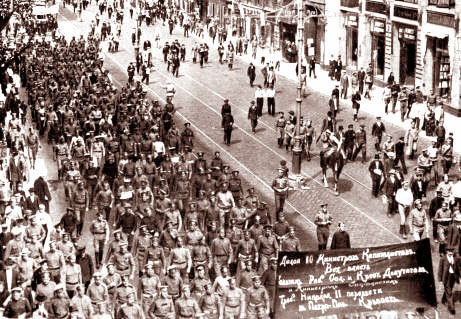
|
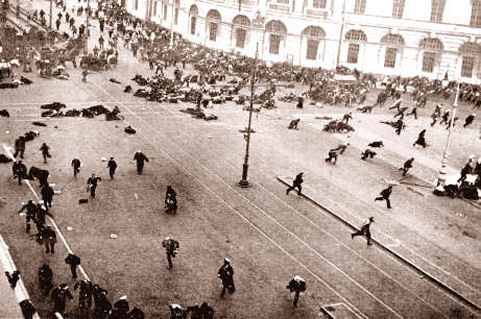
|
With the growing popularity of the Bolsheviks and the increasing isolation of the Provisional Government, Lenin decided that the time was right
to take control and urged the Central Committee to seize power. On the night of 6 November 1917 (24 October in the Russian calendar) a group of
Bolsheviks led by Trotsky staged a coup d'état storming the Winter Palace and ousting the Provisional Government. The military failed to
intervene. Within days Lenin had established the All-Russian Congress of Soviets. A new Council of People's Commissars was formed, consisting solely
of Bolsheviks, with Lenin as its Chairman.
Reaction in Turkestan
Tashkent at that time was a divided city, with the new Russian enclave sitting outside the much larger and older Muslim city. News of the Tsar's
abdication led to an upsurge in revolutionary activity, but only in the Russian quarter. Local Socialist Revolutionaries, Mensheviks, and
Bolsheviks who were Russian émigrés, union leaders, and railway workers from the local railway workshops, established the Tashkent Soviet of
Workers and Peasant's Deputies, soon to be known simply as the Tashkent Soviet.
Meanwhile the new Provisional Government in Petrograd had issued instructions for the formation of a civilian Turkestan Committee in Tashkent,
a body of former tsarist officials composed of five Russians and four Muslim natives, to take responsibility for ruling Turkestan in place of
the office of the current military governor-general, General Kuropatkin. The authority of the Turkestan Committee was also to extend over the
Khanates of Khiva and Bukhara.
Throughout 1917 the local Tashkent Soviet progressively ousted power from the official Turkestan Committee. In November they took control of
Tashkent fortress and arrested members of the Turkestan Committee. Within weeks a Congress of Soviets proclaimed Soviet rule throughout Turkestan
and established Turksovnarkom, a Turkestan Council of People's Commissars, headed by a prominent local Bolshevik.
Neither the Tashkent Soviet nor the Turksovnarkom contained a single representative of the local Muslim people, who accounted for 95%
of the population of Turkestan. The Tashkent Soviet was little more than a bunch of émigré roughnecks with a Russian colonial mentality and they
were happy to apply the idea of the dictatorship of the proletariat to the native masses of Central Asia.
The conservative Muslims of Central Asia had little interest in all of this revolutionary fervour. There were small movements of intellectuals
across Central Asia who sought reform, but of a very different type from that espoused by Marx or Lenin. They were mainly the sons of tribal
aristocrats, bays, and rich merchants, educated in local Muslim schools, Russian Universities, or in Istanbul, and they mainly wanted
modernization and autonomy.
The Jadidist movement (from the Arabic usul-i jadid, meaning new method) had sprung from the writings of Ismail-bey Gasprinsky, a Crimean
Tatar, who was a proponent of a new phonetic method of language teaching. Dissatisfied with the backwardness of Central Asia, Jadidists wanted to
reform education, apply modern science, create new civic institutions, and improve the position of women. The separate concept of Pan-Turkism was
actually a Western idea, initially proposed by the Hungarian Orientalist Arminius Vambery, who envisioned an alliance of Turkic speakers from the
Bosphorus to the Altai. The idea was later promulgated by Gasprinsky and was adopted by some Jadidists. Pan-Turkists sought greater political and
cultural unity between the Turkic peoples and liberation from colonial oppression. Some Jadidists also had nationalist leanings and wanted an
autonomous Turkestan state, not necessarily independent from Russia. At the time of the revolution Tashkent was the main Jadidist centre in Central Asia,
followed by Kokand, Samarkand, and Bukhara. There were less than 50 Jadidists in Khiva.
The Jadidists saw the Revolution as an opportunity to gain autonomy and self-governance, although not necessarily complete independence from Russia.
In April 1917 liberal Muslims had formed the Turkestan Muslim Central Council in an attempt to create a voice for the local native population. In May
they attended an All-Russian Muslim Congress in Moscow, which proposed that the Muslim territories of Russia should be governed within a democratic
federal republic. In November 1917 the Muslim Central Council approached the Turksovnarkom on the issue of Turkestan autonomy and were told
that the Soviets opposed the idea. Indeed the Congress of Soviets had already arrogantly resolved that Muslims should in any event be excluded from
all government posts because of their uncertain attitude and lack of proletarian organizations. Local Muslim activists appealed to Moscow to rein in
the Tashkent Soviet, but Stalin refused to intervene in this distant dispute. For many local Russians, Pan-Turkicism sounded like a form of Pan-Islamic
fanaticism, or worse a return to Mongol rule.
The Muslims decided to organize an Extraordinary Congress in Tashkent to discuss the future status of Turkestan, but because of concerns over possible
military intervention chose to hold it in the nearby Muslim enclave of Kokand. The Congress declared its desire for a Pan-Turkic confederation of
progressive Central Asian states, for the education and Westernization of its people, and for the modernization of its religious establishments.
The territory of Turkestan was to be autonomous but united with the Russian democratic federal state. The Congress concluded by challenging the
Soviets in Tashkent, establishing an independent provisional regional government led by young nationalists – the Turkestan Autonomous Government -
with a Peoples' Council and an Executive Committee under the head of the clergy.
The Kokand national government was a direct and potentially highly popular threat to the existence of the Turksovnarkom and at a
Qurultay of Soviets held in Tashkent in January 1918 it was declared "counter-revolutionary". Within a month Red Army forces had surrounded
and invaded the city, destroying it by fire and causing considerable loss of life. Only a handful of fugitives survived to tell the tale.
Emboldened by their success, the Tashkent Bolsheviks turned their attention towards Bukhara but their attack on the city ended in defeat. Nevertheless
Tashkent still controlled the Syr Darya, Ferghana, and Samarkand regions and throughout the remainder of 1918 and most of 1919 it persecuted their
indigenous populations, looting their homes, expropriating their lands, and creating widespread antipathy against the Soviets that would reassert itself
later through support of the popular Basmachi movement.
Meanwhile the Soviet regime in Moscow was becoming increasingly unhappy about the rising hostility towards the Bolshevik regime in Tashkent. In April
1918, with the backing of Stalin, a special emissary was sent to Tashkent with orders that Turkestan should become an autonomous republic. The local
Bolsheviks obediently held a congress and unenthusiastically formed the Turkestan Autonomous Soviet Socialist Republic or ASSR, although it would be
several years before any natives actually participated in its governance.
Reaction in Khorezm
In remote Khorezm few local people had any comprehension of developments in Russia. They were mostly poor, uneducated, illiterate, unorganized,
and overwhelmingly agrarian. There were no local newspapers, no railways, no non-Russian schools, and the only industrialization amounted to about
a dozen cotton mills. Soviet historians made much about disputes in the early 1900s over wages and conditions by Aral fisherman, barge haulers,
and soldiers and sailors in the Aral Flotilla, but such incidents were relatively minor and their importance may have been overemphasized. The
small local Russian merchant community, concentrated around Urgench and Petro-Aleksandrovsk, were more aware of developments in Petrograd especially
as some revolutionaries had been exiled to Petro-Aleksandrovsk prison.
Muhammad Rahim Khan II died of a heart attack in 1910 and was succeeded by his son, the weak and ineffectual Isfandiyar Khan (1910-1918). However
Isfandiyar's father-in-law and Divan-begi (effectively his Prime Minister), Islam Khoja, was quite the reverse - a dynamic individual who had
been influenced by his visits to Paris and Saint Petersburg and did much to drag Khiva into the 20th century, introducing the telegraph and building
the first post-office, first hospital, first pharmacy, and first Russian school. Sadly this very popular Minister was assassinated in 1913, his
modernist educational reforms having antagonized the traditional clergy. It is believed that his assassination was ordered by his archenemy, Nazar
Beg, the war minister, and was tacitly approved of by Isfandiyar Khan.
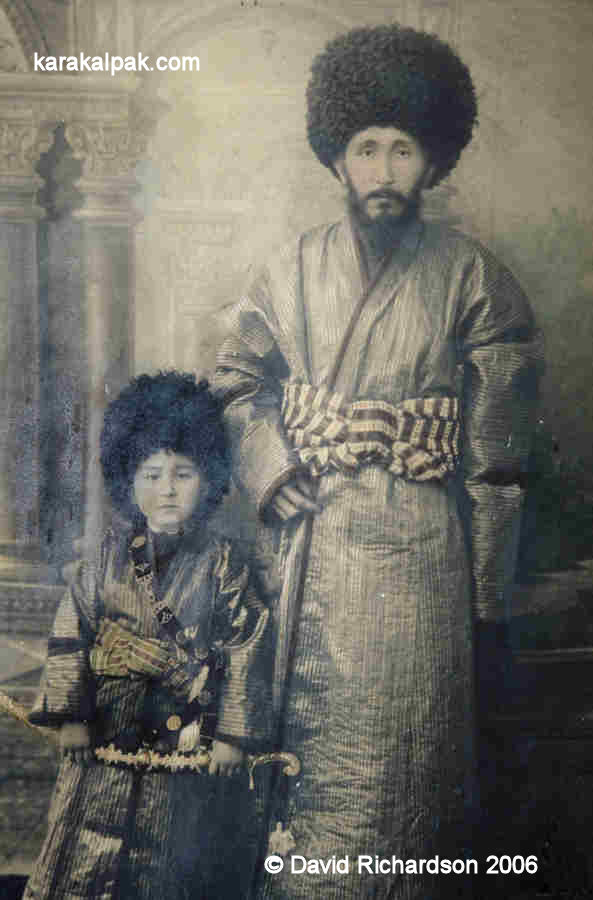
|
The main local disputes revolved around discrimination, taxation, water rights, military service, and firewood. The main expression of discontent
came from the local Turkmen population who were antagonistic towards the settled Uzbek majority and the taxes and restrictions on water rights
imposed upon them. In 1912 Isfandiyar Khan reformed the local tax system, which doubled or tripled the tax burden on the Turkmen. It needed only a
spark to ignite an open rebellion. When the Khan's officials killed a leading Turkmen for failing to hand over a criminal the local Turkmen tribes ran
riot, plundering Uzbek settlements close to Ilyaly. Nazar Beg led a punitive expedition against the Turkmen in January, but was held off for
twenty days by the well-entrenched rebels led by Muhammad-Qurban Serdar Junaid Khan, a Yomut chief. It was only after a detachment of Cossacks arrived from Petro-Aleksandrovsk
that the Turkmen agreed to a diplomatic settlement negotiated by Islam Khoja at Konya Urgench, which involved the withdrawal of the tax increase and
the payment of a one-off fine instead. The troubles surrounding water and taxation continued through 1914 into 1915. Von Martson, the exasperated
Russian governor of Turkestan, installed a Russian garrison at Khiva for the Khan's protection, even though he realized that the Khan was chiefly
to blame for his own problems. In early 1916 both the Turkmen and the Uzbeks protested against the Khan and Junaid Khan overran Khiva again, proclaiming
himself Khan. He was driven out by forces under General Galkin, governor of the Syr Darya Oblast. Petrograd ordered von Martson to
abandon his policy of support for the Turkmen and to teach them a severe lesson instead. The violent Russian reprisals lasted for two and a half
months and obliterated many local Turkmen settlements, installing deep bitterness among the local Turkmen community.
In July 1916 widespread rebellion broke out across the whole of Turkestan and the Steppe Region. The cause was an Imperial Decree cancelling the
immunity of non-Russians to military conscription. The Russians needed Central Asians for labour duties in the rear of their own forces engaged in
the First World War. This clumsy and unexpected announcement came at the height of the cotton-growing season and caused violent revolts throughout
Turkestan. The Khanates of Khiva and Bukhara were excluded from this Decree and were therefore spared from further rioting, but the Amu Darya
Otdel was not. There were numerous disturbances in right bank Khorezm, the worst being on 29 July when 600 Karakalpaks killed the local
chief of police and his wife at Shımbay. Some sense of the extensive disruption caused throughout the Khanate by the various internal disorders during
1916 can be gauged by the fact that the cotton harvest was only half of the level of the previous year.
Meanwhile the decision by the Russian authorities to commandeer large swathes of tugay forest in the Amu Darya Division for the
commercial production of firewood led to enormous resentment by Karakalpak and other peasants living in the delta, who could no longer use these
areas for grazing or for collecting firewood.
The Tsar's abdication caught Isfandiyar Khan by surprise while he was spending the winter in the Crimea and he was escorted back to Khiva by a
detachment of Russian troops. Meanwhile the Khivan Jadidists, who were all Uzbeks, had allied themselves with the soviet formed by the Russian
garrison in Khiva. They persuaded the Khan to issue a manifesto of reforms, just as the Emir of Bukhara had done a few weeks earlier. The
manifesto was actually composed by the Jadidist leader, Husayn Beg Matmuradov, and promised a constitutionally elected government, civil liberties,
a judiciary, and improvements to the schools, railways, and the post and telegraph service. A Khivan Majlis was then assembled, consisting
of thirty bays from each region of Khorezm but excluding any representatives from the Turkmen population. Matmuradov was duly elected
Prime Minister. It was only later, following pleas from the local Russian commander, that seven Turkmen chieftains were subsequently invited to
join the Majlis.
This concession failed to satisfy the troublesome Yomuts and by May 1917 they were back again, pillaging local Uzbek villages. In June a delegation
of Jadidists travelled to Tashkent to request military assistance to put down the rebellion. While the delegation of Jadidists were in Tashkent,
Isfandiyar's hakims persuaded the Khan to stage a coup d'état and to arrest Matmuradov and his Jadidist associates. A number of
Khivan Jadidists were subsequently put on trial.
The Turkmen raids continued into July when a troop of Orenburg Cossacks was finally ordered to intervene under the command of Colonel Zaitsev, who
had been appointed acting military commissar of Khiva. Zaitsev's forces did not reach the Khanate until early September and only then began to
conduct raids against the Yomut insurgents. Within a week or two Junaid Khan returned from exile in Afghanistan and offered his services to
Colonel Zaitsev to fight against the rival chieftains who were now in control of the Yomut rebels. Despite this surprising alliance Zaitsev made
little impact on the uprising, mainly because of the increasing insubordination of his troops. They were increasingly coming under the influence
of the local Russian garrison, which had been organized as a soldier's soviet and was becoming progressively disobedient towards its officers.
With the Khan firmly back in control of Khorezm and the Turkmen running riot, the Turkestan Committee came to the conclusion that the Khanate was
incapable of political and social modernization on its own. They decided to revert to the idea, proposed by Kuropatkin, of introducing reform under
military supervision with the installation of a Western-style constitutional monarchy. This would leave the Khan as the head of state alongside
an elected government, which would be responsible for the introduction of a package of comprehensive reforms. A Russian military commissar with
extensive powers would oversee the required changes.
The authority to introduce these important and long overdue reforms was finally sought from Petrograd in mid-September 1917, with a recommendation
that they should be approved by October. But the proposals became bogged down within the Russian bureaucracy. The decision had still not been
made when the Provisional Government was overthrown by the Bolsheviks in November.
Descent into Civil War
Within days officers from the former Imperial army formed the first White opposition forces in south-eastern Russia, cutting communications
between Tashkent and Moscow and isolating Turkestan from Soviet Russia. By March 1918 the Civil War had begun. Ural and Orenburg Cossacks took
over control from local soviets and the moderately socialist Mensheviks formed an interim government in the Volga city of Samara. By August
the whole of south-east Russia was under the control of anti-Bolshevik forces, with General Dutov in control of Orenburg. With the railway from
Central Asia effectively blockaded, and Moscow desperate for cotton supplies, camel caravans were used to ferry cotton from Khorezm to Emba.
Meanwhile in Transcaspia the local soviet had been ousted from power by anti-Bolshevik forces in Ashgabat, who then called on support from British
forces in Persia. This cut the railway line to the Caspian. The Turkestan Red Army was now fighting on all fronts, with some troops facing Dutov
on the Aktubinsk Front north of Emba, some fighting to the east in Semirechye, and the largest force trying to contain the uprising in Ashgabat,
leaving a residual force to maintain control in Tashkent. Even in Tashkent the Bolsheviks were not secure – in January 1919 the Tashkent Commissar
for War overthrew the local Soviet government and shot many of its members, creating consternation in Moscow. Local pro-Soviet forces violently
suppressed the rebellion, causing many deaths.
The extinction of the Kokand government had sent a brutally clear message to those Muslim leaders still contemplating national self-rule within
Central Asia. Resistance to Soviet rule now went underground in the form of a mujaheddin-like guerrilla movement, which the Bolsheviks
derogatorily termed the Basmachis, a term normally reserved for bandits and murderers. The first Basmachi campaign had taken place close to Kokand
in the Ferghana valley during 1918 and 1919 and moved on to Tashkent in 1920. The arrival of Enver Pasha, the former Minister of War for the
Ottoman Empire during the First World War, at the end of 1921 provided the Basmachis with some dynamic leadership for a brief period, during which
they managed to take control of both Dushanbe and Bukhara. Enver Pasha soon built up a considerable following and succeeded in defeating the Red
Army on several occasions. He established links with the Basmachis in Ferghana and with Junaid Khan in Khorezm. However his high profile campaign
was short-lived with the Bolsheviks managing to ambush Enver Pasha in the Pamirs during 1922. Even so the Basmachis maintained their campaign in the
region, continuing to embarrass the Soviets well into the mid-1930s.
In Khorezm Isfandiyar Khan reacted to news of the revolution by hunting down local Jadidists and other radicals, supported by Colonel Zaitsev and
Junaid Khan. However discipline within the Russian garrison was collapsing so Zaitsev ordered the pro-Bolshevik infantry regiments back to
Petro-Aleksandrovsk. Originally intending to spend the winter in Khiva and then to join up with Dutov's forces in Orenburg, Zaitsev decided to change
his plans. In January 1918 he left Khiva for Charjou with the intention of attacking opposition forces near Tashkent. When he encountered Soviet
troops outside of Samarkand, Bolshevik supporters persuaded his Cossacks to lay down their weapons, forcing Zaitsev to flee as a fugitive.
The Russian departure left Isfandiyar Khan's regime totally reliant on Junaid Khan, who commanded the only pro-Khivan armed forces in the Khanate.
Junaid Khan now exploited the timid Isfandiyar to increase his own grip on power. The Majlis was abolished and in May 1918 the Jadidist
leaders who had earlier been put on trial were executed. The handful of remaining Jadidists, who had since gone underground, escaped to Tashkent
to form a small revolutionary committee in exile, known as the Young Khivans.
While Isfandiyar remained the titular head of state Junaid Khan became the actual ruler of Khorezm, setting up a network of regional military
commanders and constructing a palace at his village of Bedirkent, close to Taxta. Taxes were raised, especially for the Uzbeks, who were also
forced to undertake compulsory labour service to clean the irrigation canals. All Turkmen were ordered to be available for military service under
Junaid. At the end of September 1918 Junaid Khan raided Urgench and stole money and property from the local Russian merchants and banks, arresting
some Russians in the process.
The Russian garrison at Petro-Aleksandrovsk had just been reinforced with Red Army soldiers under the command of a new Bolshevik military commissar,
Nikolay Shaidakov, who ordered Junaid Khan to release his Russian captives. Junaid Khan complied, but warned Shaidakov not to interfere in Khivan
affairs. Junaid realized that his security would be enhanced with Isfandiyar out of the way, especially as he could then rule through Isfandiyar's
more malleable and grateful brother, Sayyid Abdullah. In October he instructed his eldest son to go to Khiva and assassinate the Khan.
A month or so earlier Junaid had refused a request from Ashgabat to attack the garrison at Petro-Aleksandrovsk in order to slow down the Soviet
advance on Transcaspia – he felt that the mission was too dangerous, especially since Russian reinforcements could be quickly despatched by steamer
from Charjou. At the same time he knew that the nearby garrison posed a constant threat to his position. As autumn turned to winter navigation on
the Amu Darya became impossible and Junaid Khan made his move. Turkmen forces crossed the Amu Darya at six separate locations and laid siege to
Petro-Aleksandrovsk. There was an unexpected surprised when a steamer from Charjou managed to get through with reinforcements, breaking the siege
after only eleven days. In the following spring Russian troops returned from Charjou and defeated Turkmen forces on the left-bank of the Amu
Darya in the region of Pitnyak.
The Petro-Aleksandrovsk Soviet was keen to annex Khiva, but Tashkent needed all the troops it could find for the Transcaspian front. Instead they sent
a peace mission to Khorezm and negotiated a settlement with Junaid Khan, known as the Treaty of Taxta, which was signed on 9 April 1919. Khiva
would remain independent and would re-establish normal diplomatic relations and trade with Russia, who in turn would offer an amnesty to all Turkmen
charged with anti-Soviet activity. With Sayyid Abdullah Khan as his puppet Junaid Khan was firmly in charge of Khorezm and even issued coinage in
his own name. However relations with Russia remained difficult with Junaid reacting uncooperatively to a request to supply troops for the
Transcaspian campaign and then refusing to accept the Russian diplomatic representative sent to Khorezm in accordance with the terms of the Treaty.
The summer of 1919 also saw a revolt by a detachment of Cossacks based at Shımbay, who allied themselves with local Karakalpaks to take control of
the entire delta region, from No'kis up to the Aral coastline. When Shaidakov and his troops steamed down the Amu Darya to No'kis to put down the
revolt they were annoyed to be fired upon by Junaid's Turkmen supporters. After relieving No'kis, Shaidakov headed back to Petro-Aleksandrovsk in
fear of another Turkmen attack following the onset of winter. In fact Junaid Khan was already discussing the possibility of such an attack with
the rebels in Shımbay.
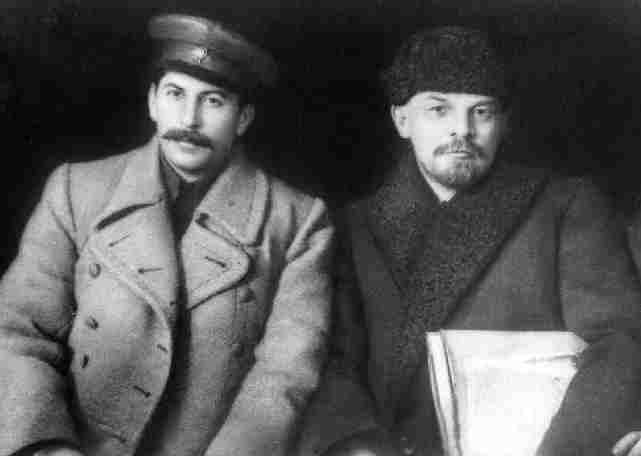
|
However for the Soviets the tide was turning. By October 1919 the European Red Army had defeated Dutov and Soviet forces from Tashkent had reached
Kyzyl Arvat in Transcaspia. Moscow had only just established a new government for Turkestan, the Commission for the Affairs of Turkestan or
Turkcommission, tasked by Lenin to rally the previously alienated Muslim masses to the Soviet cause. The focus now began to turn on the still
independent and counter-revolutionary territories of Bukhara and Khiva.
For once the smaller province of Khiva was singled out as the priority, given its outright hostility to Russia and its ongoing instability, another
revolt by Junaid's Yomut rivals having only just broken out again in Xojeli and Konya Urgench. At the same time the constant flow of disaffected
Uzbek radicals from Khiva had swollen the ranks of the Young Khivans in Tashkent from just over a dozen to a militia of around five hundred. In
November the Turkestan military authorities sent Skalov, their new military representative for Khiva, to Petro-Aleksandrovsk to organize an invasion,
just as a relief force from Charjou was extricating Shaidakov's forces from No'kis where they had been under attack by a combined force of Turkmen
and rebel Cossacks.
The Khorezm Peoples' Soviet Republic
Skalov crossed the Amu Darya on 25 December 1919 with 430 soldiers, including some leading zealots such as Faizullah Khojaev. They took Khanqa
and Urgench without a struggle, only to find themselves besieged in Urgench by Junaid Khan's troops for the following three weeks. Meanwhile
Shaidakov's army of 400 soldiers defeated the Cossack and Karakalpak rebels at Shımbay before crossing the river to take control of Xojeli, where
their numbers were swollen by rebel Turkmen forces opposed to Junaid Khan. After the fall of Konya Urgench Junaid Khan retreated to Bedirkent
to face Shaidakov's army from the north and Skalov's army to the south. After a two-day battle at Taxta, Junaid Khan escaped into the Qara Qum.
Khiva was taken on the 1 February 1920.
With the Red Army in control Sayyid Abdullah Khan, the very last Qon'ırat Khan was forced to abdicate with his power transferred to a temporary
revolutionary committee led by Hajji Pahlavan Niyaz Yusupov, a wealthy local merchant. Only a tiny minority of the Young Khivans were Communist,
yet Tashkent immediately responded to this faction's request for the establishment of a Soviet Republic in Khorezm. A political delegation was
quickly despatched to conduct elections to a nationwide congress of soviets. On 27 April the First All-Khorezm Congress of Soviets met and
agreed to abolish the Khanate in favour of an independent Khorezm People's Soviet Republic. The Young Khivans were now in control of Khorezm,
heading 10 of the 15 available departments, and with the chairman of their central committee, Hajji Pahlavan Yusupov, acting as Premier.
In September 1920 the Khorezm People's Soviet Republic concluded an extraordinary formal treaty with the Russian Soviet Federated Socialist Republic,
which superseded all previous agreements and withdrew all former Russian claims and rights over the territory. Russia recognized Khorezm's full
independence, but offered a voluntary economic and military union and assistance with economic and cultural development, including a campaign
against illiteracy and educational resources. All property, land concessions, and rights of usage of the Russian government, Russian citizens,
or Russian companies were transferred to the new government of Khorezm without compensation. Even the assets of the Amu Darya Flotilla were
transferred to a joint Khorezmian and Bukharan river authority. Soon teachers, doctors, and military instructors arrived from Tashkent and
elsewhere with supplies and equipment. Work began to establish 35 new schools and 15 adult colleges, as well as Khorezm's first national university.
Canals were repaired, bridges were built, and the telegraph was extended.
Yet Khorezm was still polarized by the enmity between the settled Uzbek and the nomadic Turkmen populations. The Young Khivans who dominated the
government in Khiva were all Uzbeks and they wanted to see the supporters of Junaid Khan, who had seized control of the Khanate, punished. About
one hundred Turkmen were arrested and shot and others were disarmed, while punitive raids were directed against villages suspected of supporting
the Turkmen rebels. In Tashkent the Turkcommission were concerned about unfolding events and sent a team of investigators to Khiva, led by
Valentin Safonov, a former Bolshevik army commander. He was alarmed to find that the Young Khivan government had no liking for Marxist socialism
whatsoever and was doing its best to block its introduction. It had even gained control of the nascent Khorezm Communist Party.
Safonov convened an all-Turkmen Congress in Khorezm at the small left-bank town of Porsa, securing the support of the Turkmen leaders to overturn
the Young Khivan government. A mass demonstration was engineered in Khiva against that government in March 1921, providing an excuse for the Red
Army to capture the government offices and to oust the Young Khivans. A governing provisional revolutionary committee was formed, consisting of
two Uzbeks, one Turkmen, one Qazaq, and a member of the Komsomol. Elections were held to form a Second All-Khorezm Congress of Soviets, which met
in May to form a new government, devoid of Young Khivans. Many of the latter had fled into the Qara Qum to join Junaid Khan, whose following
had increased dramatically after Safonov's intervention into Khorezmian affairs.
The Russians kept a close eye on subsequent events, purging the supposedly independent government and the local Communist Party at will. In October
several members of the former government were executed or imprisoned for counter-revolutionary activities, while others were arrested during the
year-long purge that followed.
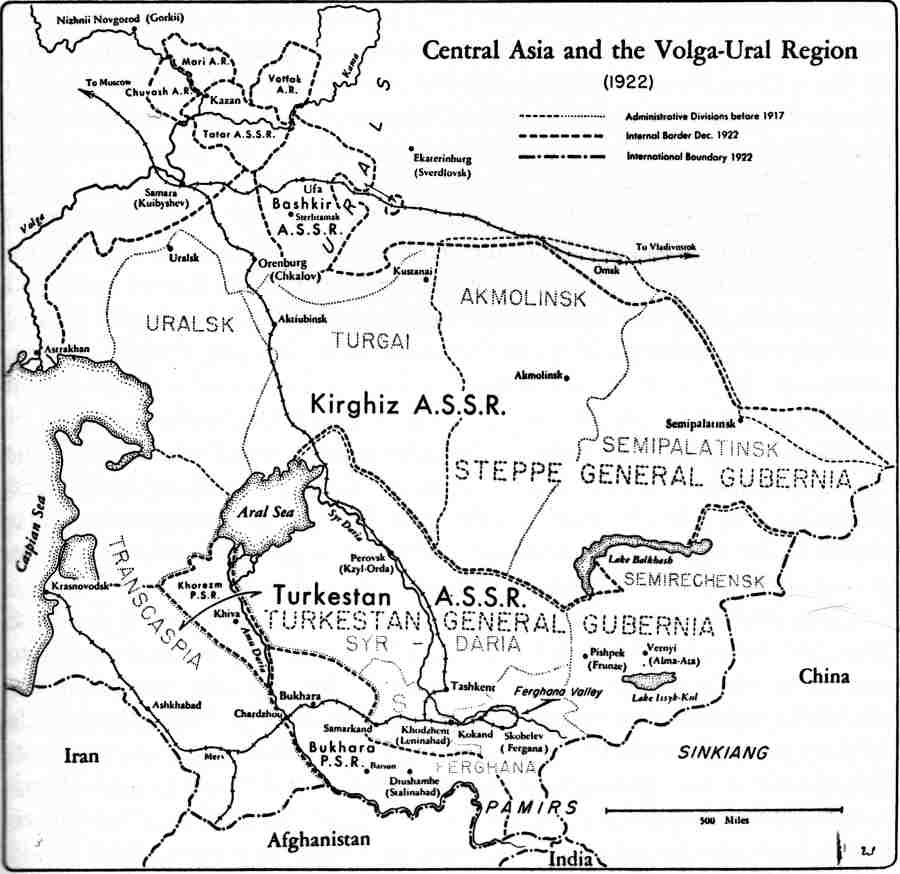
|
The Khorezm Soviet Socialist Republic
Despite the expulsion of the Young Khivans the Soviet Government remained concerned that Khorezm remained a hotbed of counter-revolution. Stalin
wanted the region transformed into a "fully socialist" society, so it was decided in 1922 that the whole of Turkestan, including Khorezm and Bukhara,
should operate as a single economic unit. The Central Asiatic Economic Council was formed to integrate all of the region's agriculture, irrigation,
post and telegraph systems, trade and monetary systems. Meanwhile Moscow took back control of the Amu Darya Flotilla. Finally the Communist Parties
of Khorezm, Bukhara, and Turkestan were merged with the Communist Party of Russia, under the supervision of the Central Asian Bureau or Sredazburo,
of the Central Committee.
During the 10th All-Russian Congress of Soviets in December 1922, Stalin referred to the problem in Khorezm:
"Two independent Soviet Republics, Khorezm and Bukhara, which are not Socialist Republics but Peoples' Soviet Republics, remain for the time being outside the union solely and exclusively because these republics are not yet socialist. I have no doubt, comrades, ... that as they develop internally towards socialism, these republics will also join the union state which is now being formed."The Russian Central Committee sent a senior hard-line Bolshevik to Khiva to conduct a ruthless purge of the local party and the government. The membership of the Khorezm Communist Party was reduced from a few thousand to a few hundred, with the expulsion of all merchants, tradesmen, and landowners. Following the purge the 4th All-Khorezm Qurultay of Soviets changed the constitution of Khorezm on 20 October 1923 to disenfranchise "all non-toiling elements". Restyled the Khorezm Soviet Socialist Republic, Khorezm had finally qualified as a "socialist" republic and now formally requested membership of the USSR.
"Muslims of Russia, Tatars of the Volga and the Crimea, Kyrgyz and Sarts of Siberia and Turkestan, Turks and Tatars of Transcaucasia, Chechens and Mountain Peoples of the Caucasus, and all you whose mosques and prayer houses have been destroyed, whose beliefs and customs have been trampled on by the Tsars and oppressors of Russia. Your beliefs and usages, your national and cultural institutions are forever free and inviolate. Organise your national life in complete freedom. This is your right. Know that your rights, like those of all the peoples of Russia, are under the mightly protection of the Revolution and its organs, the Soviets of Workers, Soldiers, and Peasants."Finland was the first part of the Empire to declare its independence after the revolution and it was followed in the first quarter of 1918 by the Ukraine, Georgia, Armenia, and Azerbaijan. Meanwhile Belarus, Estonia, Latvia, and Lithuania were encouraged to declare independence after their occupation by Germany. In July 1918 the Bolsheviks established the Russian Soviet Federated Socialist Republic, or RSFSR, with its own constitution based on a free federation of independent nations.
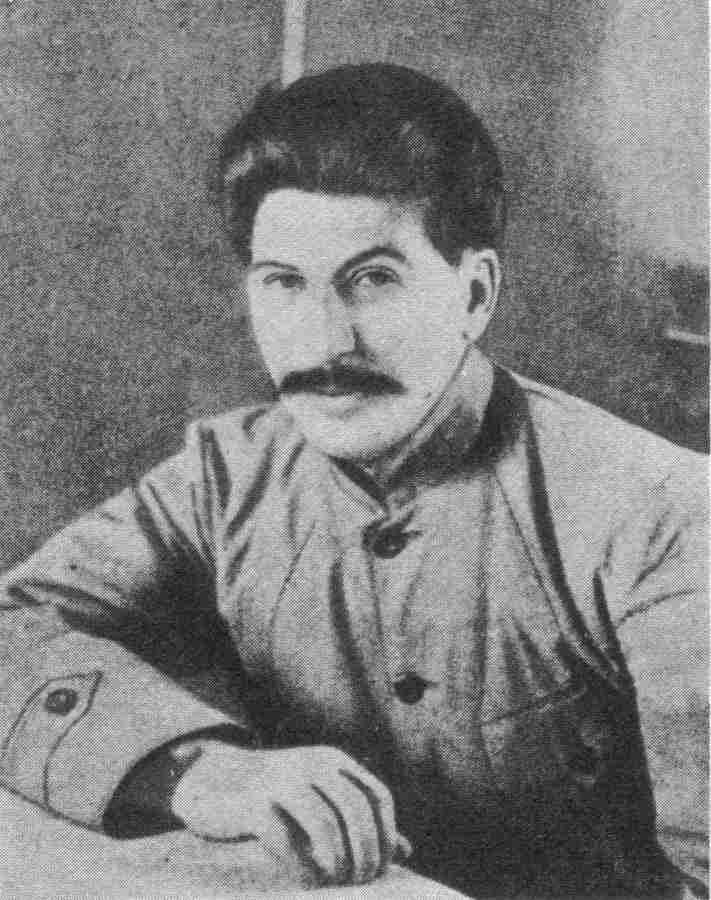
|
The policy was soon reversed. Finland had immediately become immersed in civil war, while the Ukraine, Georgia, Armenia, and Azerbaijan came under
the control of unfriendly anti-Bolshevik governments. However within a few years a combination of military and political intervention soon brought
these errant nations back into the Soviet fold, except for Finland. From now on nations would only be allowed to exert self-determination after they
had first become Communist.
There were more practical issues to consider. Turkestan and the Steppe Region had become home to about 2 million Russian immigrants who wanted to
remain an integral part of Russia. The region had huge natural resources and the Bolsheviks had no desire to leave this vast region open to
British Imperialist interests. There was also increasing concern about the potential challenge that could emerge if the various Muslim territories
of Central Asia should unite to form a pan-Islamic State. By early 1919 the new regime had dropped any idea of independent nation states, let alone
Muslim states, in Central Asia.
Lenin and the Central Committee wanted to establish an administrative structure and constitution for the new Bolshevik State. Although Marx had
argued that nation states would disappear as workers united across international boundaries, the government of such a huge ethnically and
linguistically diverse territory was unthinkable without strong provincial subdivisions. Lenin had promised "self-determination for the toilers"
and he intended to deliver this through his new nationalities policy, by transforming the RSFSR into a federation of national states that would no
longer be independent but would be "partially autonomous". The first attempt at such a structure was a failure, with the administration in Moscow
riding roughshod over the terms of the various bilateral treaties. Following complaints from the Communists of the Ukraine and Georgia, the Central
Committee of the RSFSR established a constitutional commission under Stalin.
Lenin was concerned about potential Russian ethnic domination and wanted a federation in which all nation states were equal. However Stalin believed
that the Russian government in Moscow should hold a pre-eminent position. The onset of Lenin's illness in 1922 had meant that three old-time
Bolsheviks, Zinoviev, Kamenov, and Stalin became the de facto ruling triumvirate of the USSR, effectively in control of the Politburo.
Stalin, who had just been promoted to the post of General Secretary of the Russian Communist Party in April, increasingly took control of
constitutional and nationality affairs. Stalin's initial proposal would have extended the power of the RSFSR over the so-called autonomous
republics, but was rejected by Lenin because it conflicted with his vision of a federal state and gave pre-eminence to Russia.
The compromise was the proposal to form a Union of Soviet Socialist Republics governed by a newly formed Central Executive Committee. This would be
composed of representatives from the Central Executive Committees of the member Republics. The supreme legislative body would be the Congress of
Soviets of the USSR, and its highest executive body would be the Council of People's Commissars of the USSR. The Union Republics would have their
own Commissars for finance, supply, agriculture, education, health, etc. and these would be subordinated to the corresponding agencies at
federal government level. The ratification of the Union Treaty on 30 December 1922 joined the RSFSR to the Ukraine, Belarus,
and the Transcaucasus to form the Union of Soviet Socialist Republics, or USSR. The Turkestan ASSR remained a component part of the RSFSR. The
Central Executive Committee of the USSR formally approved the Constitution of the USSR on 6 July 1923.
Lenin had already written to the Communist Party in Tashkent in 1919, asking them to investigate how many national republics should be established
in Turkestan and how they should be named. A Turkcommission was dispatched from Moscow headed by General Mikhail Frunze and Kuybishev to oversee
the current and future governance of the region. They discovered that the chauvinism of the Tashkent Bolsheviks had set local Muslims against the
revolutionaries in Moscow. The Muslim Communists wanted Turkestan to gain more autonomy as a Soviet Republic of Turkic Peoples, with its own Turkic
Red Army. However Frunze believed this was a petit bourgeois idea. He argued that Turkestan should be divided along ethnic lines, between
the Uzbeks, Turkmen, and Qazaqs. He told Lenin that the main obstacle would be a shortage of reliable native leaders. Lenin was disturbed by the
situation in Turkestan and instructed the Turkcommission to take a softer approach in order to win the support of the local population. While in
Tashkent Frunze conducted a purge among the local Russian Communists.
However Frunze's conclusion was disputed by local activists led by Ryskulov, subsequently labelled "deviationists", who submitted counter-arguments to
the Central Committee of the Russian Communist Party. They argued that the land in Central Asia tended to alternate from strips of steppe and
semi-desert suitable for nomadic pasturage to strips of alluvial land suitable for cultivation, making ethnic division problematic. Furthermore
the perceived ethnic differences in Turkestan were superficial since different ethnic groups could communicate with each other in a common dialect
within each region. Division would not only raise local sensitivities but would cause problems with long distance nomadic migrations, the management
of water, timber, and fish resources, inter-ethnic trade, and rail and telegraph communications. It would also create problems for ethnic minorities
such as the Tajiks, Karakalpaks, and Dungans.
Lenin and the Politburo considered the issue on four occasions during 1920 and finally came down in favour of the ethnic division of Turkestan.
Lenin asked for a detailed plan of how the separation would be made along with a map of the territorial reorganization. The biggest challenge was
how to divide the Soviet Peoples' Republics of Khorezm and Bukhara and this would require a detailed analysis of communications and resources such as
water, grazing pastures, land under cultivation, forests, and fishing. However little could be done on the ground until the governments and
Communist parties of Khorezm and Bukhara had been purged of local activists and filled with Soviet stooges. The formation of the puppet states of
the Khorezm SSR in October 1923 and the Bukharan SSR in September 1924 paved the way for implementing the new policy.
The Karakalpak Autonomous Oblast
Lenin died in January 1924, missing the ratification of the new Constitution of the USSR by the Second All-Union Congress of Soviets by ten days.
At the end of the month the Orgburo discussed Turkestan delimitation again. In April the matter was discussed at the Politburo and the Sredazburo
was tasked with the job of drawing up detailed proposals. Within weeks the Sredazburo set up local commissions through the Communist Parties of
Turkestan and Bukhara along with a Central Territorial Commission of its own, which in turn established Uzbek, Qazaq, and Turkmen sub-commissions.
The latter were responsible for defining the new national borders, designating capital cities, cultural and economic centres, and autonomous
oblasts. There was also a Khorezmian delegation and technical commissions were formed to resolve some of the more complex issues.
The whole matter was highly political and led to a great deal of local campaigning and agitation by the interested parties involved. Despite the
massive purge of the Khorezm Communist Party, the Executive of its Central Committee formally decided in March 1924 against an ethnic division of
Khorezm. At the same time some Karakalpaks could not see a future for their own ethnic minority in a divided Turkestan and argued for the Amu Darya
Division to be added to the Khorezm SSR.
The shorthand reports of the Central Territorial Commission are now available to researchers although some of the technical reports still remain
secret. They illustrate the difficulties faced by those involved and of the lack of consensus among the different commissions. Although the Uzbek
and Turkmen sub-commissions supported delimitation, the Khorezmian delegation fought hard to preserve the unity of its region, while the Qazaq
sub-commission supported the idea of a Soviet Central Asian Federation. The Uzbeks initially chose Samarkand as a capital, so the Qazaqs
recommended that Tashkent should be their capital city. These conflicts were resolved at Sredazburo level and some decisions required trade-offs
while others were undoubtedly influenced by the political ambitions of those involved. Some territories were deemed too small and were expanded
at the expense of their neighbours. Thus the Uzbek territories of Dashoguz, Chardjou, and Kelif were classified as Turkmen. Moscow clearly favoured
ethnic separation and saw this as a means of ending long-term feuds such as those between the Turkmen and Uzbeks.
The basic concept was that each new "nation state" would become a Soviet Socialist Republic, or SSR, with its own constitution, its own legislative,
executive, judicial institutions, and its own party structure. Each would be named after its largest ethnic population and would become members
of the USSR. Ideally an SSR should have at least one international border. Autonomous Soviet Socialist Republics, or ASSRs, would have some degree
of autonomy but would be subordinate to an SSR. Each SSR would be divided into provinces or oblasts.
The Sredazburo considered the sub-commission reports in May and resolved the following:
- to form Uzbek and Turkmen SSRs as part of the USSR,
- to form a Tajik Autonomous Oblast within the Uzbek SSR,
- to form a Kara-Kyrgyz (Kyrgyz) Autonomous Oblast within
a Republic yet to be decided,
- to transfer the Kyrgyz (Qazaqs) living in Turkestan to the
Kyrgyz (Qazaq) ASSR.
The Kyrgyz (Qazaq) ASSR had been previously formed within the RSFSR on 1 September 1920. Note that at that time the Qazaqs were referred to as
Kyrgyz and the Kyrgyz were referred to as Kara-Kyrgyz.
The issue regarding the possible formation of a Karakalpak Autonomous Oblast was still unresolved. These conclusions were endorsed
by the Politburo in June with one exception – the Khorezm SSR would be preserved as the one and only heterogeneous republic in Central Asia.
By 26 July the Khorezm Communist Party had been purged again of its "bourgeois-nationalist" elements. Under pressure it reviewed its recent
"mistaken" decision and now voted in favour of the delimitation of Khorezm. The Politburo was asked to reconsider the case and decided in favour
of ethnic division. In the same month the Turkestan ASSR transferred the island of Moynaq from the Syr Darya to the Amu Darya Division.
Following a resolution of the Central Committee of the Russian Communist Party the Sredazburo agreed that Central Asian delimitation should be
completed by October.
The Central Territorial Commission decided on 21 August 1924 in favour of creating a Karakalpak Autonomous Oblast from parts of the
Khorezm SSR and the Amu Darya Division. It was left to the sub-commissions to decide how the borders of the proposed Kyrgyz (Qazaq), Uzbek, and
Turkmen SSRs would need to be modified. Meanwhile a temporary Karakalpak sub-commission was tasked with delineating borders and starting a local
propaganda campaign. Its Chairman was Allayar Qorazovich Dosnazarov, a one-time shepherd from Kok-ozek who had worked his way up the Party ladder
and had been sent to the East Moscow Communist University from 1921 to 1923. Meetings were organized in the towns and rural districts of Shımbay
and Shurakhan sections. In Shımbay there were Uzbek protests over the possibility of rule by Qazaqs and Karakalpaks.
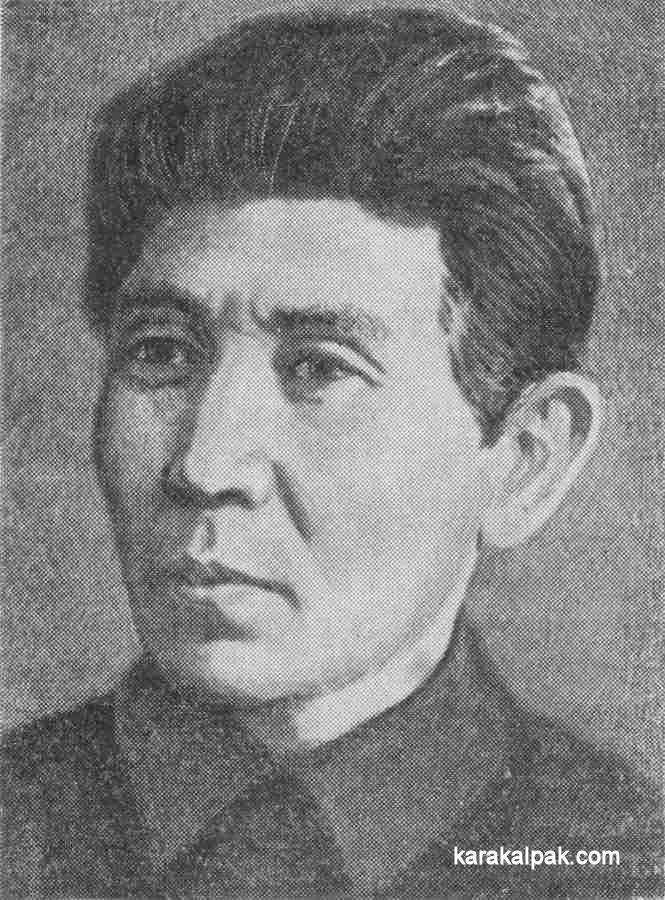
|
On 5 September the Plenum of the Regional Committee of the Amu Darya Division informed the Central Territorial Commission that the Karakalpak
Autonomous Oblast would need to be formed from the Amu Darya Division itself, plus the Qon'ırat and Xojeli regions and the Qıtay and Qıpshaq
sections of the Khorezm SSR. The Central Territorial Commission agreed that the Shımbay section of the Amu Darya Division should be transferred to
the Karakalpak region but that the Shoraxan section should go to the Uzbek section. It was left to the Sredazburo to recommend that the Karakalpak
Autonomous Oblast should include all of the Shoraxan section, apart from the district of Man'gıt, which should be transferred to the Uzbek SSR.
The Karakalpak Autonomous Oblast would form part of the Kyrgyz (Qazaq) ASSR, itself a part of the RSFSR.
A special extraordinary session of the Turkestan Central Executive Committee convened on 15 September 1924 to discuss and approve the plans for
the national and territorial delimitation of Central Asia. Within a few weeks these had been ratified by separate All-Bukharan and All-Khorezm
Qurultays of Soviets. They were finally adopted by the Bolshevik Central Executive Committee of the RSFSR on 14 October, but with a number
of amendments. The Tajik Autonomous Oblast became the Tajik ASSR incorporated within the Uzbek SSR, the Kara-Kyrgyz (Kyrgyz) Autonomous
Oblast was included within the RSFSR, and the Karakalpak Autonomous Oblast was included in the Kyrgyz (Qazaq) ASSR. On 27 October
the 11th Convocation of the Central Executive Committee of the USSR sanctioned the change at its second session in Moscow. It was not until
11 May 1925 that formal approval to the division of the Turkestan ASSR was given at the 12th All-Russian Qurultay of Soviets.
The Presidium of the Qazaq Central Executive Committee authorized the transfer of the Karakalpak Autonomous Oblast into the Qazaq ASSR
on 17 October, making way for the formation of a revolutionary committee to temporarily govern the new Karakalpak Oblast. Meanwhile a
liquidation committee, Likvidcom, was established to allocate livestock, cultivated land, and business assets between the newly delineated republics
and oblasts. Thus for example the Karakalpak Autonomous Oblast was allocated 380,745 cattle.
The First Constitutive Congress of the Soviets of the dekhans, seamen, and Red Army deputies of the Karakalpak Autonomous Oblast
was held in its new capital, the city of To'rtku'l (Petro-Aleksandrovsk prior to the revolution), from 12 to 19 February 1925. This resulted in
the formation of an Executive Committee and the selection of 40 delegates to attend the forthcoming All-Qazaq Qurultay of Soviets. Decisions
were made concerning Karakalpak administration, education, economic, and agricultural development including a planned expansion of cotton growing.
The Karakalpak Autonomous Oblast was divided into four regions and twenty six rural districts:
| Region | Districts |
|---|---|
| To'rtku'l | Biy-Bazar |
| Sarı-biy | |
| To'rtku'l | |
| Sheik-Abbaz-Valiy | |
| Ming-bulak | |
| Tamdı | |
| Shoraxan | |
| Shımbay | Da'wqarin |
| Kegeyli | |
| Kok-O'zek | |
| Qon'ırat | |
| Na'wpir | |
| No'kis | |
| Taldıq | |
| Shımbay | |
| Yani-Bazar | |
| Xojeli | Qarateren' |
| Qıpshaq | |
| Qıtay | |
| Lauzan | |
| Miskin-Atin | |
| Xoja-Yarmish | |
| Qon'ırat | Kyuzyl-Yar |
| Xaniyab | |
| Moynaq | |
| Toqmaq-ata |
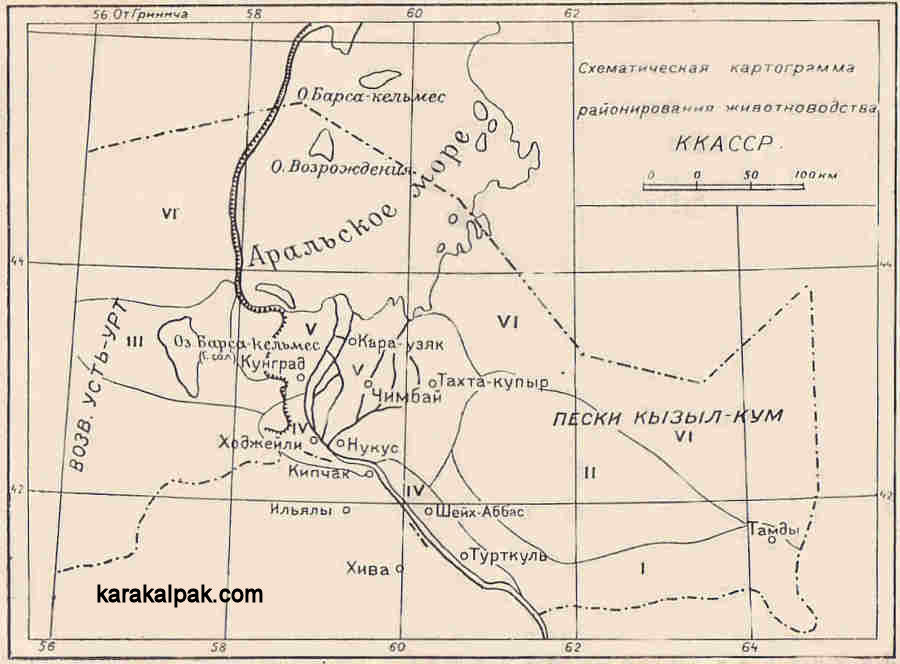
|
It was against this background that attention increasingly focused on the underperforming regions of the USSR, including the Karakalpak Autonomous
Oblast. Its incorporation into what had now become the Qazaq ASSR had been a disaster. The Karakalpak Autonomous Oblast not
only lacked the skilled technicians required to develop its agricultural, livestock, and fishing industries, but also the educational resources to
train them. It had gone from a backwater of the Russian Empire to a backwater of the Qazaq ASSR, located 1500 km to the west of Alma-ata and not
even connected to Kazakhstan by road. Since its creation little had been done to modernize its agricultural economy. A few cooperatives and machine
hire centres had been established but most farms remained under the control of beys and the clergy. In 1928 the Karakalpak Oblast
had only 3 tractors, 83 ploughs, 79 harrowers, and 62 seeders. Collectivization began in the second half of 1928, but by the end of the following year
the total number of kolxoz had only reached 33. The achievement of the targets laid down in the First Five Year Plan demanded more
radical changes.
On 20 July 1930 the Presidium of the All-Russian Central Executive Committee approved the decision to remove the Karakalpak Autonomous
Oblast from the Qazaq ASSR and to include it directly within the Russian Federation. Russian technocrats were sent to Karakalpakia
from Moscow, Leningrad, and Ivanovo to investigate the reasons for its sluggish economic performance. They concluded that the region suffered from
a weak technical infrastructure for its agricultural industries, it had an insufficiently developed irrigation network, collectivization was not
proceeding fast enough, the administration and targeting of the collective and state farms that it had was not properly organized, transport was
inadequate, there were labour shortages, and the organization and management of provincial and district government was poor.
The Council of People's Commissars of the RSFSR considered a report on the region on 1 August 1931 and agreed to a number of its recommendations.
These included a major expansion in the Shımbay irrigation system, an increase in the cotton acreage, a new state rice farm, a cotton cleaning plant,
four new agricultural machinery depots, a hydro-electric station, an major expansion of technical education to increase the number of veterinary,
irrigation, and fishing specialists, and a new pedagogical institute. There would also be a new print works in addition to an expansion of the existing
printing house in To'rtku'l in order to increase the amount of technical literature available in the Karakalpak language.
As agricultural collectivization progressed during the crucial years of 1930 and 1931, it placed an enormous burden on local administrators and
officials. A massive programme was initiated across the RSFSR to re-elect and strengthen local soviets, removing those who might oppose collectivization
in favour of loyal supporters. After the 1930-31 elections to the Karakalpak Qurultay of Soviets, 122 of the 192 deputies were Communist Party
members and 45 were women. The initiative also led to an increase in Karakalpak Communist Party membership, which exceeded 4,000 during 1932.
Inadequacies in Karakalpak local government and administration led to calls for the region's status to be elevated from an Autonomous Oblast
into an Autonomous Republic. The Executive Committee of the Karakalpak Autonomous Oblast considered the matter and issued a recommendation
to the Central Executive Committee of the Russian Communist Party that such a conversion would support a speeding up in the reconstruction of the
Karakalpak economy.
An emergency meeting of the Executive Committee was held on 5 March 1932. After considering the prospects for the future development of
Karakalpakia it was decided to place a petition in front of the Presidium of the All-Russian Central Executive Committee. The Presidium met on
20 March 1932 and agreed that the region should be converted to the Karakalpak Autonomous Soviet Socialist Republic within its existing boundaries.
It would now become a federal member of the RSFSR. The First Qurultay of Soviets of the Karakalpak ASSR would be responsible for electing
the Central Executive Committee and for organizing the new apparatus of state in accordance with the constitution of the USSR. This took place
two months later on 25 May 1932 in To'rtku'l. In addition to the Central Executive Committee, the Qurultay established a Council of
Peoples' Commissars. Peoples' Commissariats were formed for justice, education, public health, social welfare, light industry, agriculture,
municipal services, labour, supply, finance, and peasant and worker inspection.
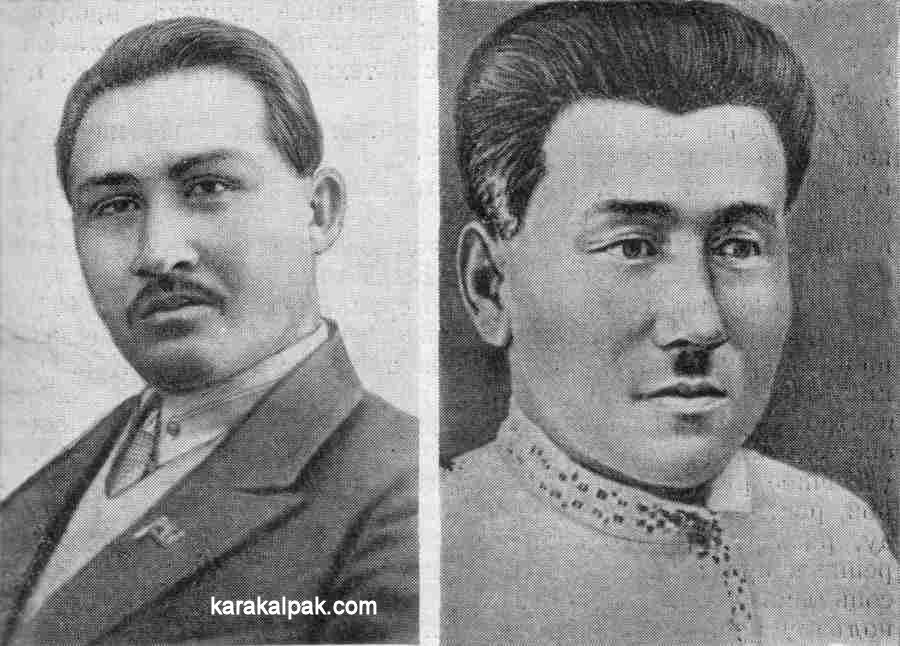
|
The first session of the Central Executive Committee was convened on 30 May 1932. Ko'ptlew Nurmukhamedov was appointed as its first Chairman and
Qasım Avesov became the Chairman of the Council of Peoples' Commissars of the Republic. Nurmukhamedov only lasted for two years, Avesov becoming the
Karakalpak leader in 1934.
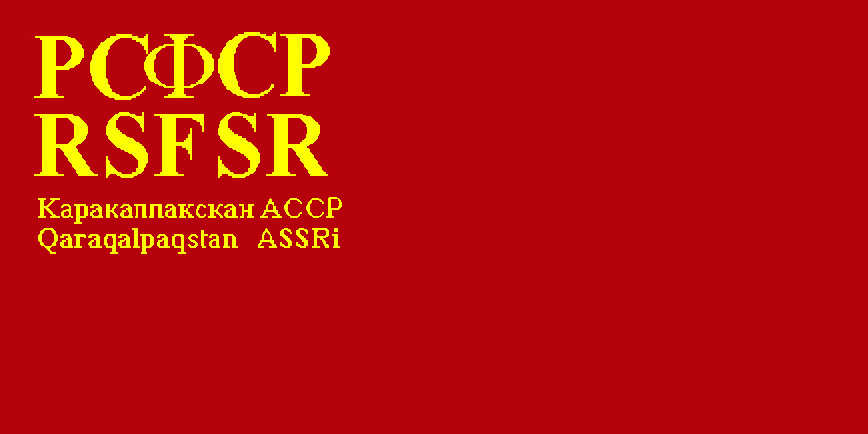
|
Entry into the Uzbek SSR
The first half of the 1930s saw unprecedented changes throughout Karakalpakia. Owners of land and livestock, including the clergy, had their
property confiscated, and those who refused to cooperate were exiled to Siberia camps and their sons were conscripted into the Red Army, often
never to be seen again. There was widespread resistance, some of it organized, with bays attempting to influence village soviets and
to intimidate officials. The implementation of collectivization seems to have progressed relatively smoothly for ordinary peasants and workers,
many of them glad to be rid of their oppressive landlords. Most of the people inhabiting the delta lived within extended families that were essentially
already operating as a collective unit, and the collectivization process involved little more than combining several family groups belonging to
the same clan into a single economic unit. Two types of farm appeared: the state farm, or sovxoz (short for sovetskoe khoziaistvo)
and the more common collective farm, or kolxoz (short for kollektivnoe khoziaistvo). The fishermen at Moynaq were also organized
into kolxoz, and industrial activities were nationalized and organized into artels.
Enormous pressure was applied to the new collectives to plant cotton, pressure that they resisted because the price for cotton was low. Even so the
output of cotton doubled during the First Five-Year Plan (1928-32), as did the area of land under irrigation. At first political commissars were
assigned to the collectives to ensure compliance but then, in 1934, cotton prices were raised by 500%. Cotton immediately became highly attractive,
being referred to as "white gold" and the cotton acreage soon increased. Now the challenge was to raise cotton yields and this was achieved by
the increasing application of mineral fertilizers from 1935 onwards.
The economy benefited from an influx of skilled workers and technicians, ranging from tractor drivers to agronomists and accountants. The number of
kolxoz reached 500 at the end of the First Five-Year Plan and 1,000 by the end of the Second. For the first time in many generations
ordinary people began to see significant improvements in their standard of living, education, and welfare.
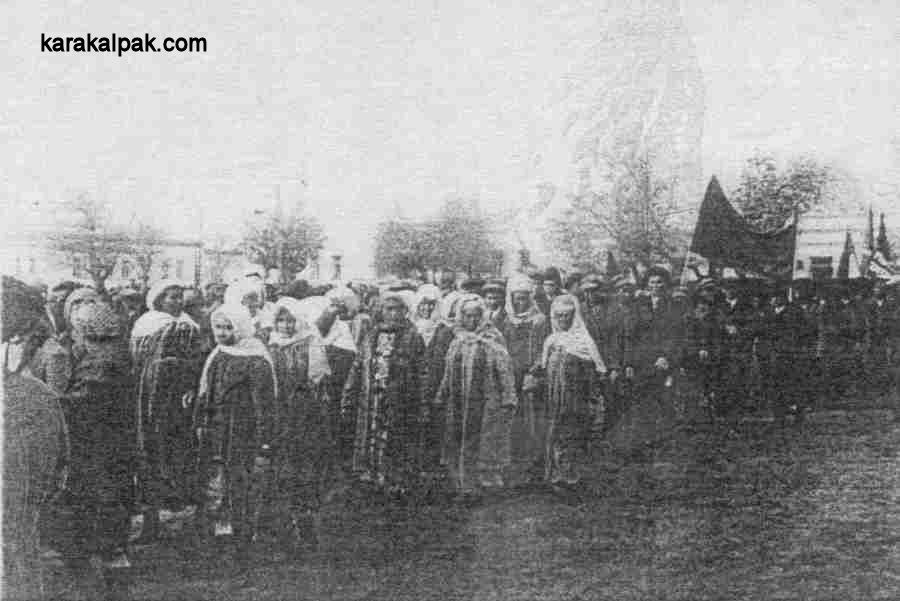
|
There were also changes to the boundaries of the Karakalpak ASSR in 1935, with agreement over a new border between the Qıpshaq and Xojeli regions
and the Kalinin and Konya Urgench regions of the Turkmen SSR, and the delineation of the Karakalpak and Qazaq regions of the Ustyurt and Aral Sea.
Ironically in Moscow work was progressing on the drafting of a new Constitution of the USSR, just as Stalin was embarking on his reign of terror and
laying the foundations for a completely totalitarian state. The USSR was to become a democratic federation of eleven Soviet Socialist Republics,
any of which could leave the union if it so wished. It included Russia and the five Central Asian Republics of Kazakhstan, Kyrgyzstan, Uzbekistan,
Tajikistan, and Turkmenistan. It was clear that it no longer made sense to include the Karakalpak ASSR as a part of the Russian SSR. The two were
not physically linked other than by air, and the cotton-based economy of Karakalpakia was more like that of its neighbouring Republics. The Uzbek
SSR had the agricultural and industrial base to provide support for Karakalpakia and was well connected to it by road, rail, and river. It also
had the political resources to assist its neighbour in the building of its government and Communist Party structure.
The idea of transferring the Karakalpak ASSR to the Uzbek SSR was very attractive to politicians in Tashkent, since it would greatly extend the
size of their country and increase its agricultural and mineral resources, particularly the Aral fishing industry and the Qara Qum gold deposits.
Uzbek officials persistently lobbied the Kremlin to gain support for the move.
The so-called Stalin Constitution was introduced in November 1936, although few people took it seriously. It was approved by the Eighth
Extraordinary Congress of Councils of the USSR on 5 December 1936, thus formally transferring the Karakalpak ASSR to the Uzbek SSR.
On 12 February 1937 the Sixth Extraordinary Congress of Councils of the Uzbek SSR approved the new Uzbek Constitution. The new Constitution
of the Karakalpak ASSR was approved by its own Congress on 23 March 1937. On paper it granted all of its citizens full democratic freedoms and
rights, independent of nationality or race.
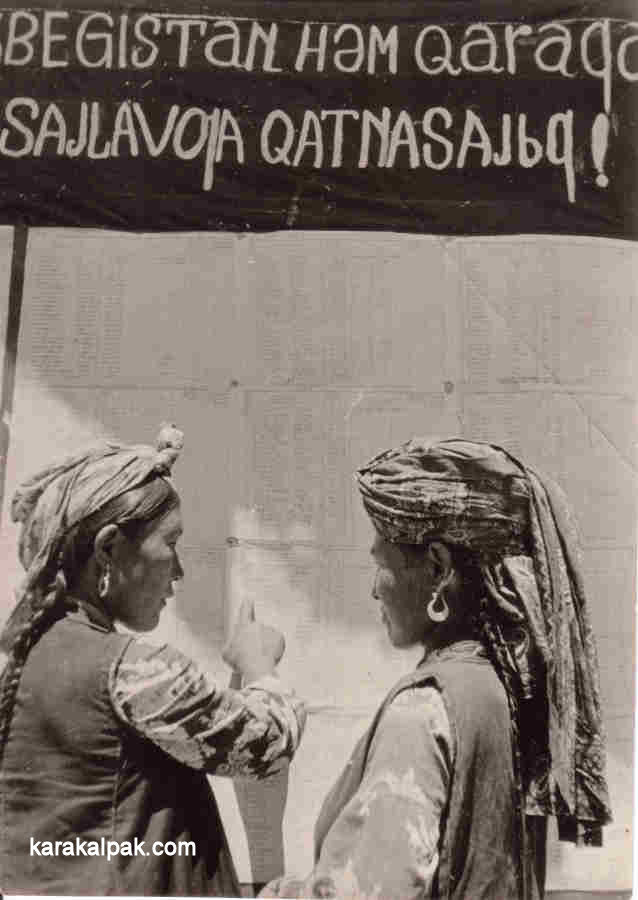
|
Elections for the Central Committee were held in Karakalpakia on 6 December 1937. There were no competing candidates - one member of the Communist
Party stood for each position. V. A. Khomutnikov became the Chairman of the Central Executive Committee and the following year took on the new title
of President of the Presidium of the Supreme Soviet of the Karakalpak ASSR, a position he maintained until 1947. Jumbay Kurbanov remained Chairman of
the Council of People's Commissars.
Post Script
Critics of Tsarist imperialism were obliged to support the concept of self-determination. However Lenin and Stalin's endless writings about the
subject suggests it was an issue they were never really comfortable with. Yet their acceptance of the independence of Poland, Finland, and the Ukraine
after the October 1917 coup d'état shows that they genuinely supported a policy of national independence at that time.
Marxist historical theory had predicted that the unity of nation states was an inevitable consequence of revolution. Once in power, Lenin and Stalin
had to rapidly modify their beliefs in the face of political realities. Unity was only achievable through military might and the concept of autonomy
became a convenient means of creating the illusion of self-determination within an increasingly totalitarian system.
Stalin had accepted the Marxist idea that history would inevitably lead to ethnic separation and incorporated such views in his writings, elevating
them to the status of scripture. But Stalin was more down-to-earth than Lenin and saw the political benefits of an ethnic delineation: the ability
to "divide and rule" regional states, the creation of barriers to Turkic or Islamic unification, the elimination of ethnic conflict, and the
opportunity to create the illusion of self-determination.
The practical arguments of Ryskulov counted for little in the face of the overwhelming desire of the Soviet leadership to control and unify a vast
and diverse empire recently torn apart by civil strife.
In the end the territorial division of Central Asia was badly conceived, badly planned, and badly rushed. Even the Chairman of the Sredazburo,
Zelenskiy, admitted that the work was "done with an axe". Yet given the ethnic mosaic of Central Asia a perfect division along ethnic lines was
impossible. The task of ethnically dividing up Turkestan was something like the equivalent of trying to divide up a multi-ethnic country like
Afghanistan today. The idea of ethnically defined nations with fixed borders was quite alien to the essentially tribal people who lived there,
whose identity was based on family and clan ties and whose concept of territory was linked to their oasis, farm settlement, or pasturage. When
the Bolsheviks sought advice from the renowned Orientalist Vasiliy Barthold he told them that the idea ran contrary to historical experience and
would be a great folly.
The outcome made it difficult to coordinate the water management, land use, and communications of the lower Amu Darya region. Instead of being
separated into three Khanates the Uzbeks found themselves spread across six new administrative territories, with important enclaves in northern
Turkmenistan, southern Karakalpakstan, and southern Kazakhstan. Meanwhile the allocation of the Tajik cities of Bukhara and Samakand to the Uzbek
SSR divided the Tajik population. At least the subsequent reunification of Karakalpakstan and Uzbekistan has gone some way to repair the damage.
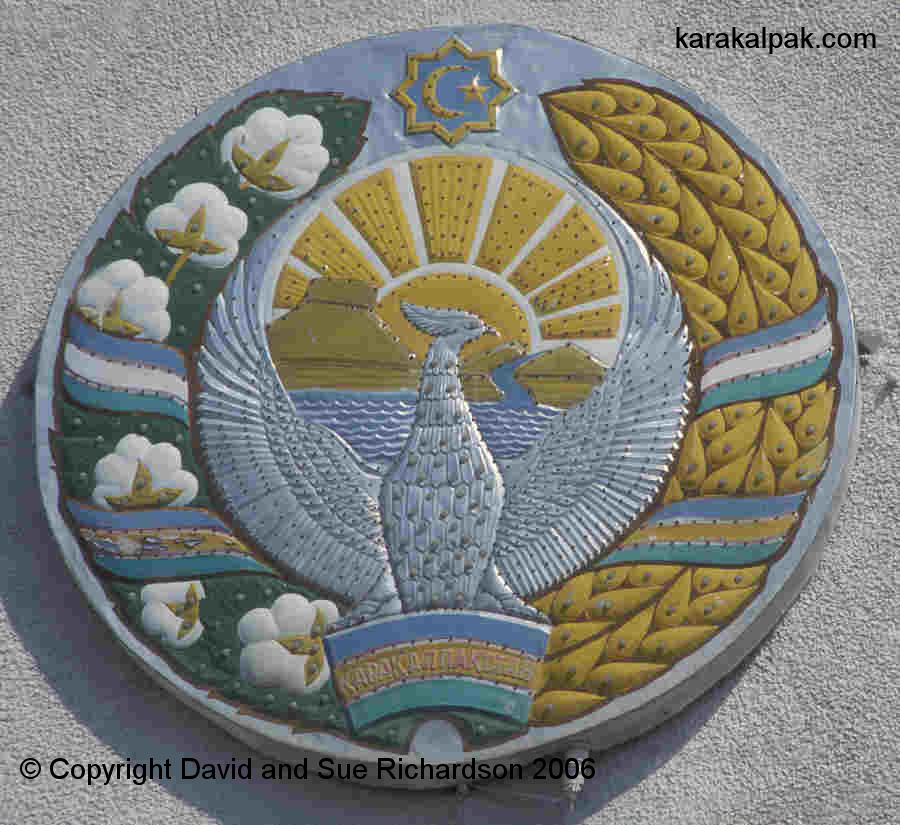
|
The real problems of ethnic delineation have only fully emerged after the collapse of the Soviet Union. The fragmentation of Central Asia into
independent but insecure Republics, each jealously guarding their new international borders has created a travesty for the region. The major
problem for the Khorezm oasis region is its partitioning into isolated Uzbekistan and Turkmenistan halves. Communications have been disrupted;
families divided; markets fragmented; regional trade paralyzed. Smuggling has become the main growth industry. If one example alone is enough
to illustrate the current madness it is the need for Uzbekistan to develop a self-contained railway system in order to avoid the delays and
taxation incurred through the use of the established direct lines through Turkmenistan.
References
Allworth, E. A., Central Asia, a Century of Russian Rule, Columbia University Press, New York, 1967.
Allworth, E. A., The Modern Uzbeks. From the Fourteenth Century until the Present, Hoover Institution Press, Stanford, 1990.
Babushkin, L. N., Soviet Uzbekistan, Progress Publishers, Moscow, 1973.
Badretdin, S., Pan-Turkism: Past, Present and Future, Turkoman Magazine, London, December 1998.
Becker, S, Russia's Protectorates in Central Asia: Bukhara and Khiva, 1865 – 1924, Harvard University Press, Cambridge, Massachusetts, 1968.
Blank, S., The Sorcerer as Apprentice: Stalin as Commissar of Nationalities, 1917-1924, Westport, Connecticut, 1994.
Carrère d'Encausse, H., The Great Challenge: Nationalities and the Bolshevik State, 1917-1930, Holmes and Meier, New York, 1992.
Deutscher, I, Stalin, A Political Biography, Pelican Books, 1966.
Dosumov, Ya. M. and Ametov, K. A., The national demarcation of Central Asia and the formation of the Karakalpak autonomous region, Chapter 4, History of the Karakalpak ASSR, Volume 2, Fan Publishing House, Tashkent, 1986.
Dosumov, Ya. M. and Bekimbetov, A., Karakalpakia in the period of socialist industrialization and agricultural collectivization (1926-1932), Studies in the History of the Karakalpak ASSR, Volume 2, Chapter 4, Nauka Publishers, Tashkent, 1964.
Khalid, A., The Politics of Muslim Cultural Reform: Jadidism in Central Asia, University of California Press, Berkeley, 1998.
Lansdell, H., Russian Central Asia, Houghton, Mifflin and Company, Boston, 1885.
Maillart, E. K., Turkestan Solo, translated by John Rodker, G P Putnam's Sons, New York, 1935.
McCauley, M., The Russian Revolution and the Soviet State 1917 – 1921, Documents, The Macmillan Press, London, 1975.
Nutmukhamedov, M. K., Muminov, I. M., and Dosumov, Y. M., History of the Karakalpak ASSR, Volume 2, Fan Publishing House, Tashkent, 1986.
Paksoy, H. B., Nationality or Religion?: Views of Central Asian Islam, AACAR Bulletin of the Association for the Advancement of Central Asian Research, Volume 8, Number 2, Autumn 1995.
Pierce, R. A., Russian Central Asia 1867-1917, University of California Press, Berkeley and Los Angeles, 1960.
Pipes, R., The Formation of the Soviet Union: Communism and Nationalism 1917-1923, Cambridge, Massachusetts, 1997.
Rahimov, M., and Urazaeva, G., Central Asian Nations and Border Issues, Conflict Studies Research Centre, Defence Academy of the UK, Camberly, 2005.
Rashidov, S., Soviet Uzbekistan, Progress Publishers, Moscow, 1982.
Schuyler, E., Turkistan, Sampson Low, Marston, Searle and Rivington, London, 1876.
Skrine, F. H. B., and Ross, E. D., The Heart of Asia, Methuen and Co., London, 1899.
Smith, J., The Bolsheviks and the National Question, 1917-1923, Macmillan, London, 1999.
Tatybaev, S. U., The Victory of Socialism in Karakalpakia (1933-1937), The Karakalpak ASSR in the period of the completion of the socialist reconstruction of the national economy, Studies in the History of the Karakalpak ASSR, Volume 2, Chapter 5, Nauka Publishers, Tashkent, 1964.
Tatybaev, S. U., Formation of the Karakalpak ASSR, Chapter 7, History of the Karakalpak ASSR, Volume 2, Fan Publishing House, Tashkent, 1986.
Treadgold, D. W., Twentieth Century Russia, Westview Press, Boulder, Colorado, 1995.
Von Laue, T. H. and A., Faces of a Nation - The Rise and Fall of the Soviet Union, 1917-1991, Fulcrum Publishing, Colorado, 1996
Visit our sister site www.qaraqalpaq.com, which uses the correct transliteration, Qaraqalpaq, rather than the
Russian transliteration, Karakalpak.
 |
This page was first posted on 17 July 2006. It was last updated on 27 February 2012. © David and Sue Richardson 2005 - 2015. Unless stated otherwise, all of the material on this website is the copyright of David and Sue Richardson. |